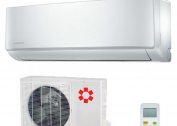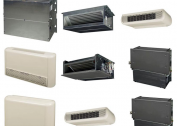Cassette air conditioner is a device for maintaining a comfortable climate in highly walkable rooms with an area of 50-300 square meters. m. Attaches to the ceiling and evenly distributes cooled or heated air on 4 sides. Performs 3 tasks: cools, heats and purifies indoor air.
Features of cassette air conditioners
The cassette-type ceiling air conditioner is designed according to the traditional split-system scheme: it consists of two units - external and internal, connected by a freon highway (route). The first is mounted on the outside of the wall of the building, the second - indoors, in a suspended ceiling. The external unit is designed as a standard air conditioning unit. The inner one is placed in a protective cassette, square or rectangular, with a front panel in diameter similar to a tile of a suspended ceiling. Behind is a cleaning filter.
The distribution of airflow cassette air conditioner occurs in four directions from top to bottom, evenly distributing the coolness or heat in the room. Compared to classic domestic air conditioning, cassette models do not create drafts. Ducts have an increased area compared to wall mounted devices. The angle of inclination of the louvers regulating the air flow pressure is controlled by the remote control.
The installation of the cassette involves a suspended ceiling with a ceiling space of 25-40 cm.
Scope of application
Cassette-type split system - semi-industrial climatic equipment. It belongs to air conditioners of a hidden type: it does not stand out against the background of the interior - the decorative grille fits into it. Mounted behind a false ceiling. It is suitable in rooms where the minimum ceiling height is 3 meters. It is in demand in public crowded areas: offices, shops, cafes, fitness clubs, restaurants, libraries, exhibition halls. In apartments of multi-storey buildings it is rarely used, but it is suitable for a spacious country cottage with high ceilings.
Equipment specifications
Cassette air conditioners stand out with a cooling capacity of 3.5-20 kW. One device copes with maintaining a comfortable climate in a room with an area of up to 180 square meters. m. On the market of HVAC equipment there are single-threaded and multi-threaded models:
- dual threaded;
- three-line;
- four-threaded.
The external air conditioning unit includes:
- compressor;
- electronic control board;
- fan blowing condenser;
- protection;
- heat exchanger.
The indoor unit includes:
- centrifugal fan for supplying chilled air;
- filter for cleaning the air coming from the outside;
- heat exchanger and evaporator for cooling the air flow;
- a pipe for removing condensate from the evaporator;
- blinds on the front panel for air flow control;
- temperature and motion sensor (on some models).
The indoor unit must be built into the suspended ceiling. The dimensions of the equipment take this factor into account. Manufacturers produce models for different lengths and widths of ceiling cells:
- square 60 × 60, 70 × 70, 90 × 90 cm;
- rectangular 60 × 70, 60 × 90, 60 × 120, 70 × 90, 70 × 120, 90 × 120 cm.
Pay attention to the height of the indoor unit - the thinner the case, the lower the power of the equipment.
The cassette-type inverter air conditioner is equipped with an improved power system that allows you to adjust the speed of the compressor motor. The equipment operates in an increased temperature range, for the most part being in a low-power mode, which saves electricity. Periodic switching on, harmful to the compressor unit, is not required for such an air conditioner, the compressor is not threatened with starting loads.
Advantages and disadvantages of technology
Pros:
- Power: one device supports a comfortable microclimate in the area, which requires 2-3 wall split systems.
- Speed: the air heats up or cools quickly due to the direction of air flow on 4 sides.
- Appearance: the front panel of the external unit fits into the strict interior design of public places, and the lower edge of the case is parallel to the ceiling.
- Sound: cassette-type equipment produces a low noise: air cooling rate is enhanced by increasing the area of the ducts, and not the intensity and pressure of the air flow.
- Economic benefit: the price of one cassette is lower than several wall-mounted models.
Minuses:
- Features of installation: installation is possible only in a suspended ceiling.
- Room requirements: for optimized cassette operation, ceilings with a height of 3 meters and above are suitable.
The main thing when choosing a cassette-type air conditioner
 Before buying, you need to determine the characteristics of the room and make sure that there are physical and technical conditions in order to install the external and internal units. It's about installation, proper operation and painless dismantling of equipment, if necessary. When making a choice, rely on the characteristics of the mains, for example, a three-phase air conditioner must be connected to 380 V.
Before buying, you need to determine the characteristics of the room and make sure that there are physical and technical conditions in order to install the external and internal units. It's about installation, proper operation and painless dismantling of equipment, if necessary. When making a choice, rely on the characteristics of the mains, for example, a three-phase air conditioner must be connected to 380 V.
The power of the equipment is determined by the area of the room. Ignoring this principle will lead to inadequate air conditioning or wasteful use of electrical resources. To calculate the power, divide the room area by 10, for example, in the trading floor, 150 sq.m. need a cassette with a power of 15 kW.
Do not confuse cooling power with heating power and power consumption.
Another method of calculation is 1 kW per 10 square meters. m. area. It will turn out the same figure. These are simplified methods - in practice, it is advisable to use information about the type of room, about the lighting, the number of people and equipment that leads to air heating. Knowing the required power, we focus on the desired dimensions, functionality, price.
The cost varies: it’s possible to buy a room compact version for 50,000, semi-industrial equipment is many times more expensive - up to 500,000 rubles. If you want to save on electricity, buy an air conditioner with an inverter.
Mounting for free with your own hands using the instructions with a photo or video from the Internet is a bad idea, so add the cost of installation work and the price of consumables for installation to the price. This is another 10-40 thousand rubles.
Installation of HVAC equipment
To optimize the operation of the air conditioner, the indoor unit is installed in the center of the room, and the failed communications are hidden by the design of the suspended ceiling. Installation of a cassette air conditioner is carried out only by professionals and includes the steps of:
- Installation of the outdoor unit on the external wall of the building and the laying of communication components.
- Installation of the indoor unit on the ceiling of the room.
- Laying air ducts.
- Cable connection
- Fixing the air mixing device (if available).
- Mounting the front panel of the indoor unit.
- Carrying out commissioning works.
Installation of the indoor unit of cassette air conditioners begins with a partial analysis of the ceiling:
- remove one or 2-3 plates;
- install fasteners for the cassette, fixing it on the ceiling with suspensions on the anchor bolts included in the kit;
- having removed the cassette lattice, the indoor unit of the air conditioner is fixed on the suspensions inside;
- connecting the refrigerant circuit and connecting the equipment to the power line;
- connect the condensate drain system.
Installation Recommendations
The cassette-type indoor unit is installed so that the front panel is flush with the ceiling surface. If the air conditioner includes a mixture of external circulation air, the air duct is carried out, after which a purification filter and an air damper are attached. During the operation of the equipment, the air will be cooled and diluted with a fresh, previously purified stream from the street.
The front decorative grille of the indoor unit is to be installed after installation of the components of the climatic equipment and cosmetic decoration is completed. At the last stage, power is turned on and equipment is turned on. In the absence of installation errors and the correct operation of the system, it remains to carry out individual settings for the air conditioner.
Device Operation Rules
In addition to careful handling of the equipment, maintenance of cassette air conditioners includes periodic cleaning or replacement of air filters (at least once a year) and other preventive operations. To gain access to the filters, it is not necessary to disassemble the ceiling - they remove the decorative panel of the block. With round-the-clock operation in a room with a significant load, regular maintenance includes:
- cleaning filters and drain pan;
- inspection of the drainage pipe and refrigeration circuit;
- topping up refrigerant;
- cleaning both air conditioning units and the outdoor unit heat exchanger;
- power cable check.





